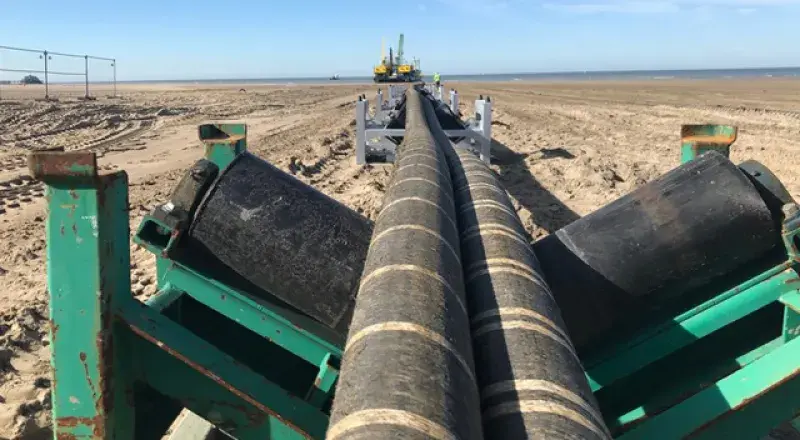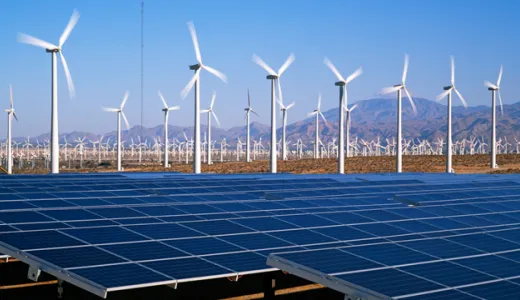What are electricity interconnectors?
Electricity interconnectors are high-voltage land and subsea cables that connect the electricity systems of neighbouring countries. They enable surplus clean energy to be traded and shared between countries and help manage surges in demand in both countries.
As we deploy more wind power to meet our climate and energy security targets, connections to our neighbouring countries will play a vital role in increasing security of supply and helping to reduce prices.

How do interconnectors help make the energy network greener?
Interconnectors allow us to move surplus renewable electricity from where it’s in abundance to where it’s needed.
For example, our North Sea Link interconnector connects Blyth in the UK with the Norwegian village of Kvilldal and enables power sharing between the two countries. When weather conditions mean that supplies from UK wind farms and solar are lower, we can draw on carbon-free Norwegian hydro power. Meanwhile, on windy or sunny days in Britain, our excess renewable energy can be sent via the interconnector to Norway.
Sharing energy in this way makes the most of the green energy sources we have available and enables us to manage the system while avoiding costly constraints.
What other benefits do interconnectors have?
The benefits of interconnection with neighbouring countries include:
- Security of supply: Interconnection strengthens the security of energy supplies by providing flexible and reliable access to large volumes of electricity. Neighbouring countries can support each other when domestic energy production isn’t sufficient to meet demand.
- Connecting much more renewable energy: To meet its net zero targets, the UK needs to connect huge volumes of renewable energy resources in the next decade, particularly offshore wind. Interconnection maximises the use of renewable energy by giving an efficient way to both import and export clean power.
- Balancing rapid changes and demand: Renewable generation is less predictable than traditional thermal generation, which means in future it could prove more challenging for electricity system operators to balance supply and demand. Interconnection helps to smooth out these peaks and troughs by making large amounts of electricity available at the touch of a button.
- Lowering energy bills: When cheaper power is available from neighbouring countries, it can be imported and vice versa, helping to give Britain access to lower-priced electricity. As increased interconnection helps to bring down wholesale prices, consumers could benefit from lower energy bills in the long term.
How many interconnectors does National Grid have?
National Grid operates six interconnectors, connecting the UK with France (IFA and IFA2), The Netherlands (BritNed), Belgium (Nemo Link), Norway (North Sea Link) and our most recent interconnector (Viking Link) became operational on 29 December 2023, joining the UK with Denmark.
Find out more about our interconnectors

How deep under the sea are interconnectors and how long are they?
Constructing subsea interconnectors is a remarkable engineering task – some are laid in waters up to 600 metres deep and the cables can be hundreds of kilometres long.
Stretching for a record-breaking 470 miles (757km), Viking Link holds the GUINNESS WORLD RECORDSTM title for the world’s longest land and subsea HVDC interconnector. With a capacity of 1.4GW it can transport enough green electricity to power up to 2.5 million UK homes.
How much of of Britain’s electricity is sourced via interconnectors?
National Grid owns and operates six of Great Britain’s nine interconnectors, with 7.8GW of interconnected capacity – equivalent to powering 3.2 million homes for a year or removing 156.8 million cars off the road in the same time period.
What is an Offshore Hybrid Asset (OHA)?
Interconnectors currently operate ‘point to point’, meaning that they connect one country’s energy system to another’s. But given the huge increase in offshore wind capacity needed to help achieve net zero, the next generation of interconnection will see offshore wind and interconnectors working together as a combined asset, creating an offshore hub for green energy.
OHAs (formerly known as multi-purpose interconnectors), would connect clusters of offshore wind farms to multiple countries at once via interconnectors. We’re developing a new generation of innovative OHAs that will help to speed up the connection of offshore wind and maximise the use of wind generation. OHAs will also reduce the impact on local communities as they would reduce the amount of connection points and onshore infrastructure required to connect this clean energy to the shore.
When was the first subsea electricity interconnector built and where?
The first subsea electricity interconnector entered operations in 1961, linking the UK and France. National Grid’s first interconnector, Interconnexion France-Angleterre (IFA), was commissioned in 1986 and also links the UK with France.
How can I see how interconnectors are helping the UK?
You can find out more about interconnectors and the role they play in the green energy transition on our website – The power of partnerships.
Last updated: 19 Aug 2024
The information in this article is intended as a factual explainer and does not necessarily reflect National Grid's strategic direction or current business activities.

Find out more about interconnectors
Find out why interconnectors are becoming such an important part of our energy system, how they’re developing to share even more energy in the future and why they’re already playing a big part in helping us to reach net zero carbon emissions.

Interconnectors – separating the myths from the facts
There are a lot of common misconceptions about interconnectors and the role they play in helping us to reach net zero. Here we address your concerns and questions about interconnectors and have asked our experts to bust the most common myths about these giant undersea electricity cables.



